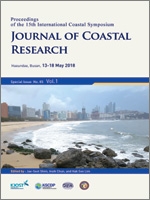Pan, M.J.; Kong, J.; Luo, Z.Y., and Lv, Z.J., 2018. Influence of typhoon path on salt water intrusion in the Modaomen Waterway, China. In: Shim, J.-S.; Chun, I., and Lim, H.S. (eds.), Proceedings from the International Coastal Symposium (ICS) 2018 (Busan, Republic of Korea). Journal of Coastal Research, Special Issue No. 85, pp. 936–940. Coconut Creek (Florida), ISSN 0749-0208.
Three-dimensional baroclinic model was applied in the Modaomen Waterway to analyze the effect of typhoon path on salt water intrusion. Taking typhoon ‘Nesat’ (the west-path typhoon) and ‘Usagi’ (the east-path typhoon) as examples, two opposite dynamic effects on saltwater transport and stratification were discovered. Influenced by typhoon remote wind, the east-path typhoon leads to the set-down of coastal sea level, which increases the oceanward advective flux. While the west-path typhoon results in the set-up of coastal sea level that promotes the oceanward advective flux landward and causes more serious salt water intrusion. Influenced by typhoon local wind, the west-path typhoon with the up-estuary local wind tends to reduce stratification. However, the east-path typhoon with the down-estuary local wind is likely to enhance stratification under moderate wind, but reduce stratification when the wind stress increases. Besides, it should be mentioned that with respect to time-varying salinity value, a bimodal characteristic appeared during the process of typhoon Nesat. The salt flux decomposition and the numerical experiments were adopted to investigate this mechanism underlying the formation. Results show that the first peak was caused by periodic salt water intrusion in the control of steady shear salt flux during neap-spring cycle with low river discharge, while the latter peak resulted from the oceanward advective flux suddenly turning to landward in the control of sea level setup.





